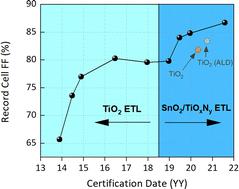当前位置:
X-MOL 学术
›
Energy Environ. Sci.
›
论文详情
Our official English website, www.x-mol.net, welcomes your feedback! (Note: you will need to create a separate account there.)
Performance limitations imposed by the TCO heterojunction in high efficiency perovskite solar cells
Energy & Environmental Science ( IF 32.5 ) Pub Date : 2022-10-28 , DOI: 10.1039/d2ee01742c Daniel Walter 1 , Jun Peng 1, 2, 3 , Klaus Weber 1 , Kylie R. Catchpole 1 , Thomas P. White 1
Energy & Environmental Science ( IF 32.5 ) Pub Date : 2022-10-28 , DOI: 10.1039/d2ee01742c Daniel Walter 1 , Jun Peng 1, 2, 3 , Klaus Weber 1 , Kylie R. Catchpole 1 , Thomas P. White 1
Affiliation

|
The power conversion efficiency of perovskite solar cells (PSCs) has risen rapidly, but continuing this trend requires a clear view of all possible sources of power loss. Over the past decade in which we have witnessed these remarkable improvements, the transparent conductive oxide (TCO) has been widely treated as an extrinsic element. While it is recognised that the TCO contributes power loss due to finite lateral resistance and optical losses, comparatively little attention has been paid to the influence of the TCO on the electrostatics in other cell layers. However, a recent fill factor (FF) record on a centimetre-scale PSC has refocused attention on how the TCO can play a significant role in the optoelectronic properties across the entire TCO-transport layer-perovskite interface. Primarily, this is the consequence of the Schottky-type heterojunction formed between the TL and TCO layers, which establishes a space-charge region within the TL. Due to the extreme thinness of many TL layers, the space charge region can extend the full width of the TL and even into the perovskite layer itself. In effect, the bulk properties of the TL come to be dominated by the equilibrium conditions of this junction, with the consequence that the TL can be markedly less conductive once in situ within a PSC. This in situ resistance can significantly reduce FF, but without knowledge of this mechanism, the source of resistance and FF loss would be non-obvious. In this contribution, we employ ionic–electronic device models to quantify the TCO-induced in situ conductance of the transport layer and demonstrate its characteristic appearance in the JV curves of high-performance PSCs. We posit that widely used titanium dioxide (TiO2) can be particularly susceptible to a low in situ conductance, which explains the years-long plateau of FFs in TiO2-based PSCs in the low 80%-range. By comparison to inverted PSCs, we illustrate how the TCO influence can explain comparative underperformance of FF relative to open-circuit voltage and photocurrent in state-of-the-art n–i–p PSCs. We hope that by refocusing attention on this factor of PSC design, this work can provide a facile path to plausibly lifting single junction PSCs beyond 26% efficiency.
中文翻译:

TCO异质结在高效钙钛矿太阳能电池中的性能限制
钙钛矿太阳能电池 (PSC) 的功率转换效率迅速提高,但要延续这一趋势,需要清楚地了解所有可能的功率损耗来源。在我们目睹了这些显着改进的过去十年中,透明导电氧化物 (TCO) 已被广泛视为一种外在元素。虽然人们认识到 TCO 由于有限的横向电阻和光学损耗而导致功率损耗,但相对较少关注 TCO 对其他电池层中静电的影响。然而,最近在厘米级 PSC 上的填充因子 (FF) 记录使人们重新关注 TCO 如何在整个 TCO-传输层-钙钛矿界面的光电特性中发挥重要作用。首先,这是在 TL 和 TCO 层之间形成肖特基型异质结的结果,它在 TL 内建立了空间电荷区。由于许多 TL 层非常薄,空间电荷区可以延伸到 TL 的整个宽度,甚至延伸到钙钛矿层本身。实际上,TL 的整体特性受此结的平衡条件支配,其结果是 TL 的导电性可能会明显降低。在PSC 内原位。这种原位阻力可以显着降低 FF,但如果不了解这种机制,阻力和 FF 损失的来源将是不明显的。在这项贡献中,我们采用离子电子器件模型来量化 TCO 诱导的传输层原位电导,并在高性能 PSC的JV曲线中展示其特征外观。我们假设广泛使用的二氧化钛 (TiO 2 ) 可能特别容易受到低原位电导的影响,这解释了 TiO 2中 FFs 长达数年的平台期。基于 80% 范围内的 PSC。通过与倒置 PSC 的比较,我们说明了 TCO 影响如何解释 FF 在最先进的 n-i-p PSC 中相对于开路电压和光电流的性能相对较差。我们希望通过重新关注 PSC 设计的这一因素,这项工作可以提供一条简单的途径,将单结 PSC 的效率提高到 26% 以上。
更新日期:2022-11-01
中文翻译:

TCO异质结在高效钙钛矿太阳能电池中的性能限制
钙钛矿太阳能电池 (PSC) 的功率转换效率迅速提高,但要延续这一趋势,需要清楚地了解所有可能的功率损耗来源。在我们目睹了这些显着改进的过去十年中,透明导电氧化物 (TCO) 已被广泛视为一种外在元素。虽然人们认识到 TCO 由于有限的横向电阻和光学损耗而导致功率损耗,但相对较少关注 TCO 对其他电池层中静电的影响。然而,最近在厘米级 PSC 上的填充因子 (FF) 记录使人们重新关注 TCO 如何在整个 TCO-传输层-钙钛矿界面的光电特性中发挥重要作用。首先,这是在 TL 和 TCO 层之间形成肖特基型异质结的结果,它在 TL 内建立了空间电荷区。由于许多 TL 层非常薄,空间电荷区可以延伸到 TL 的整个宽度,甚至延伸到钙钛矿层本身。实际上,TL 的整体特性受此结的平衡条件支配,其结果是 TL 的导电性可能会明显降低。在PSC 内原位。这种原位阻力可以显着降低 FF,但如果不了解这种机制,阻力和 FF 损失的来源将是不明显的。在这项贡献中,我们采用离子电子器件模型来量化 TCO 诱导的传输层原位电导,并在高性能 PSC的JV曲线中展示其特征外观。我们假设广泛使用的二氧化钛 (TiO 2 ) 可能特别容易受到低原位电导的影响,这解释了 TiO 2中 FFs 长达数年的平台期。基于 80% 范围内的 PSC。通过与倒置 PSC 的比较,我们说明了 TCO 影响如何解释 FF 在最先进的 n-i-p PSC 中相对于开路电压和光电流的性能相对较差。我们希望通过重新关注 PSC 设计的这一因素,这项工作可以提供一条简单的途径,将单结 PSC 的效率提高到 26% 以上。



























 京公网安备 11010802027423号
京公网安备 11010802027423号